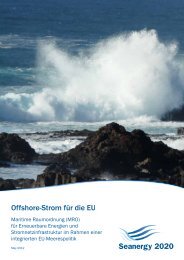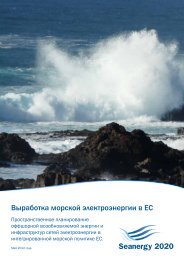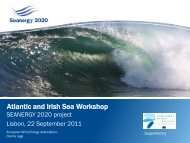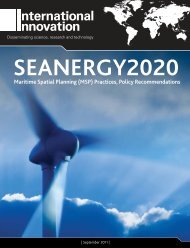Comparative analysis of Maritime Spatial Planning ... - Seanergy 2020
Comparative analysis of Maritime Spatial Planning ... - Seanergy 2020
Comparative analysis of Maritime Spatial Planning ... - Seanergy 2020
Create successful ePaper yourself
Turn your PDF publications into a flip-book with our unique Google optimized e-Paper software.
insurmountable. There are a number <strong>of</strong> good reasons to stimulate the development <strong>of</strong> <strong>of</strong>fshore windenergy, also in this area.High population density means high electricity demand in the coastal states surrounding theMediterranean. This important regional electricity demand <strong>of</strong> potentially 150 million consumers couldbecome one <strong>of</strong> the driving forces if this region chooses to stimulate the development <strong>of</strong> clean, safeand local ORE 30 . An ORE driven energy policy in the Mediterranean could generate a beneficial socioeconomicimpact by creating a new maritime industry sector with new employment opportunities.A sea basin specific MSP policy and adapted legal framework may help overcome the „natural‟disadvantages <strong>of</strong> the Mediterranean Sea. Mediterranean coastal states could be supported, like theBaltic countries, in their exercise to develop pilot MSPs in territorial seas and in high seas areas. TheEU could support the development <strong>of</strong> demonstration zones by, for instance, co-funding soilinvestigation campaigns, Strategic Environmental Assessments and Research and Development inthe floating substructures technology.3.1 POLICY AND LEGAL FRAMEWORK3.1.1 Barriers and obstacles for <strong>of</strong>fshore RE: the maritime zones delimitation issue 31The Mediterranean Sea basin is a particular case since 53 % <strong>of</strong> its maritime zones are under the highseas regime. Territorial waters, established by coastal States over a width <strong>of</strong> 12 nautical miles (6nautical miles for Greece) represent only 16 % <strong>of</strong> the total surface area. Few states have asked foran exclusive economic zone, but some have declared new types <strong>of</strong> zones, which are not covered bythe law <strong>of</strong> the sea, such as fishing zones or ecological protection zones. These specific zones cover31 % <strong>of</strong> the surface <strong>of</strong> the Mediterranean.As stated before 32, legally binding delimitation <strong>of</strong> maritime zones is considered to be a prerequisitebefore any marine spatial planning policy can begin to develop. This basic principle equally applies tothe Mediterranean. The fact that no Mediterranean state33 so far has extended its jurisdictionbeyond the territorial sea is considered as an important obstacle for developing <strong>of</strong>fshore renewableenergy in this area.30 ORE combined with solar energy and hydro-electricity to balance the intermittent nature <strong>of</strong> <strong>of</strong>fshore windenergy.31 Source: www.fao.org/32 See MRAG report on comparison <strong>of</strong> MSP procedures in 17 EU countries, April 201133 Except for MonacoDeliverable D 2.369 | P a g e






